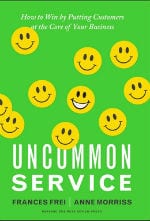 What’s more important to your customers: cost savings or good service? For field service companies, that can be a tough tradeoff. At a time when a single truck roll can cost over $1,000 a pop, great service often can’t come without a bump in prices. But there are ways around that dilemma, says Anne Morriss, co-founder of the Concire Leadership Institute and co-author of “Uncommon Service: How to Win by Putting Customers at the Core of Your Business.”
What’s more important to your customers: cost savings or good service? For field service companies, that can be a tough tradeoff. At a time when a single truck roll can cost over $1,000 a pop, great service often can’t come without a bump in prices. But there are ways around that dilemma, says Anne Morriss, co-founder of the Concire Leadership Institute and co-author of “Uncommon Service: How to Win by Putting Customers at the Core of Your Business.”
Case in point: Progressive Insurance. When a Progressive customer gets in a car crash, the company sends an Immediate Response Vehicle to the scene to handle all the paperwork, take photos, and in some cases cut the customer a check on the spot — sometimes before the police file a report. So how does Progressive pay for this without hiking up insurance premiums?
“It’s actually a huge cost-reduction for them,” Morriss explains. “It dramatically limits fraud — and that’s a big piece of their cost structure. It’s a very creative way to fund great service, and it doesn’t involve asking customers to carry that [cost] burden. It more than pays for itself.”
Morriss offers four tips to designing similar schemes for providing great service at no additional cost.
1. Deliver on What Customers Want Most
 You can’t be great at everything. Most important is to figure out what your customers care about most — which might be different than what you think they care about — and over-perform on those things.
You can’t be great at everything. Most important is to figure out what your customers care about most — which might be different than what you think they care about — and over-perform on those things.
“In services, trying to do it all brilliantly will lead almost inevitably to mediocrity,” Morriss says. “Excellence requires sacrifice. … This means you must have the stomach to do some things badly.”
So spend some time figuring out what your customers’ priorities are, then look at how you can re-arrange what your service department does best to take advantage of what your customers want most. By focusing your resources on being great at a few things, you’ll blow your customers’ socks off — and they probably won’t notice or mind that you can’t compete on things they don’t care about.
2. Get Serious About Self-Service
 Promoting client self-service kills two birds with one stone: It can help slash costs while delivering great value to customers. But only if you do it right. Some customers can handle certain tasks on their own (minor repair jobs, straight-forward installations) as long as you give them the tools or information to tackle it. Verizon started offering a number of self-service options through its online portal a couple of years ago — a step in the right direction, says Morriss.
Promoting client self-service kills two birds with one stone: It can help slash costs while delivering great value to customers. But only if you do it right. Some customers can handle certain tasks on their own (minor repair jobs, straight-forward installations) as long as you give them the tools or information to tackle it. Verizon started offering a number of self-service options through its online portal a couple of years ago — a step in the right direction, says Morriss.
“Finding out how much self-installation customers can handle — it can be hard to get right,” Morriss says. “But there’s been a lot of innovation here in the last 10 years, and self-service is really a big opportunity in this space.”
Online how-to video tutorials, live chat or phone agents who can talk someone through an easy fix — and a functioning, easy-to-use website where customers can handle everyday tasks like bill-pay, repair ticket creation, or order products — will limit the number of frustrated phone calls, and potentially the number of truck rolls, saving money and improving service.
3. Offer Online Scheduling
One simple way to offload costs without sacrificing value is to let customers schedule their own service calls. Show a calendar with all your available times and dates, and let them pick online, without making them call in and navigate the 15-minute wait time to speak with a live agent.
“We’ve seen some health-care organizations experiment with this,” Morriss says. “It’s so much faster and easier for me to take all that calendar information that’s in my head — I gotta take the kids here, pick up my mom there — and just look online and make those trade-offs in my mind. People see a lot of value in that, and that’s something we haven’t seen much yet.”
4. Consider a Premium Offering
We know how much people hate waiting for a service technician. Would customers pay more in order to get a service that arrives at a specific time — no four-hour waiting periods? “Absolutely, no question,” Morriss says. “That’s the difference between giving up a workday and not. I can put an economic value on that.”
It’s important for organizations to challenge assumptions they may make about their customers — especially their willingness to pay a premium for great service. In many cases, offering knockout customer service is actually more valuable to people than just costs.
“Lots of people think the market isn’t willing to pay for outstanding service. But that just doesn’t hold up to reality,” Morriss says. There’s an emotional connection people make with a company when someone just treats them decently. Think about that. Find ways to creatively offer and fund that level of service, and you’ll have invested and loyal customers.
More: How Comcast Killed the Four-Hour Service Window.
Click here to download a free whitepaper, “Five Steps to Make Field Service Profitable.”

Share this: